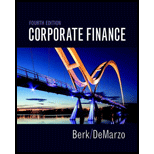
a.
To determine: The yield to maturity of the bond.
Introduction:
A yield to maturity (YTM) is the
b.
To determine: The expected
Introduction: A yield to maturity (YTM) is the rate of return projected for a security or a bond which is apprehended till its maturity period. It is also considered as the internal rate of return (IRR) for a security or bond and it likens the current estimation of a bond’s future cash flow to its present market cost. A coupon payment is the yearly interest payment that is remunerated to a bondholder by the issuer of the bond, until the point that the debt obligation matures. The coupon payments are cyclic payments of interest to the bondholders.
c.
To determine: The expected return on investment if there is a 100% probability of default and recovery of 90% of the face value is possible.
Introduction:
A yield to maturity (YTM) is the rate of return projected for a security or a bond which is apprehended till its maturity period. It is also considered as the internal rate of return (IRR) for a security or bond and it likens the current estimation of a bond’s future cash flow to its present market cost. A coupon payment is the yearly interest payment that is remunerated to a bondholder by the issuer of the bond, until the point that the debt obligation matures. The coupon payments are cyclic payments of interest to the bondholders.
d.
To determine: The expected return on investment if the default probability is 50%, the likelihood of default is greater in bad times than good times, and, in the case of default, recovery of 90% of the face value is possible.
Introduction:
A yield to maturity (YTM) is the rate of return projected for a security or a bond which is apprehended till its maturity period. It is also considered as the internal rate of return (IRR) for a security or bond and it likens the current estimation of a bond’s future cash flow to its present market cost. A coupon payment is the yearly interest payment that is remunerated to a bondholder by the issuer of the bond, until the point that the debt obligation matures. The coupon payments are cyclic payments of interest to the bondholders.
e.
To determine: Risk-free interest rate
Introduction: A yield to maturity (YTM) is the rate of return projected for a security or a bond which is apprehended till its maturity period. It is also considered as the internal rate of return (IRR) for a security or bond and it likens the current estimation of a bond’s future cash flow to its present market cost. A coupon payment is the yearly interest payment that is remunerated to a bondholder by the issuer of the bond, until the point that the debt obligation matures. The coupon payments are cyclic payments of interest to the bondholders.
Want to see the full answer?
Check out a sample textbook solution
Chapter 6 Solutions
Corporate Finance (4th Edition) (Pearson Series in Finance) - Standalone book
 EBK CONTEMPORARY FINANCIAL MANAGEMENTFinanceISBN:9781337514835Author:MOYERPublisher:CENGAGE LEARNING - CONSIGNMENT
EBK CONTEMPORARY FINANCIAL MANAGEMENTFinanceISBN:9781337514835Author:MOYERPublisher:CENGAGE LEARNING - CONSIGNMENT
